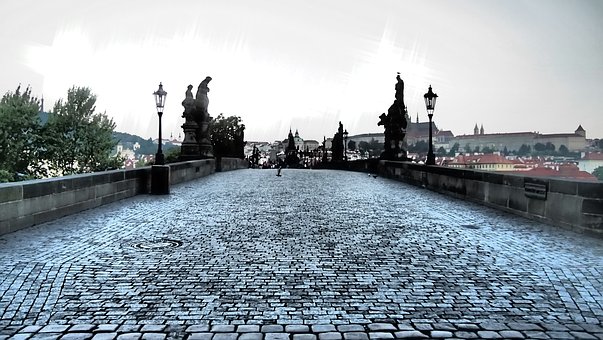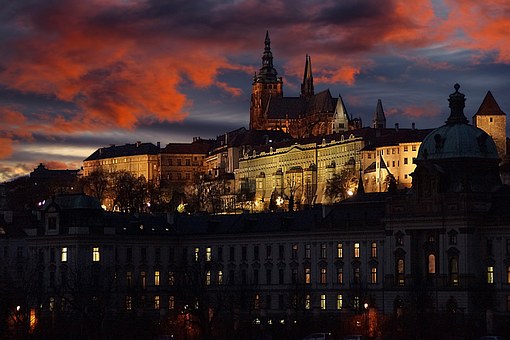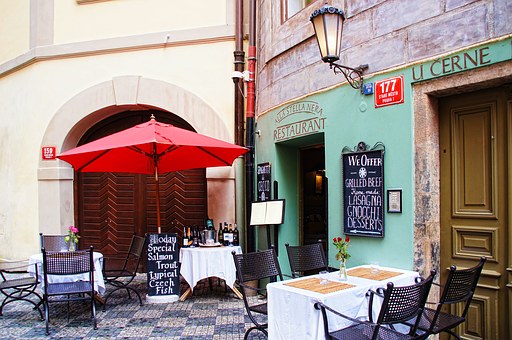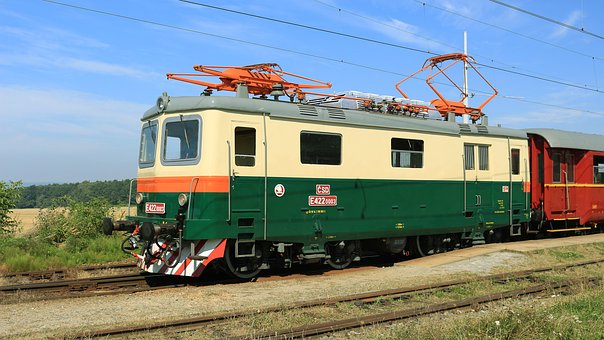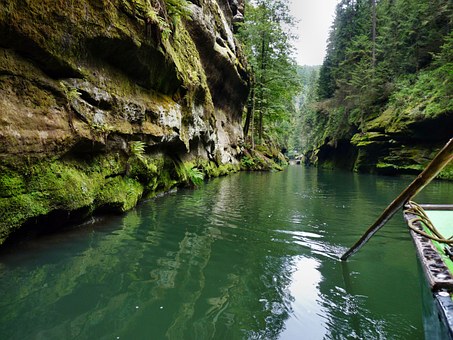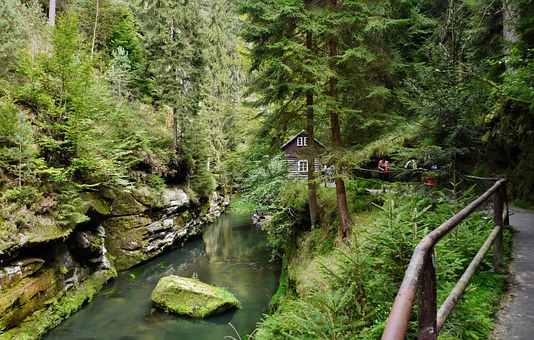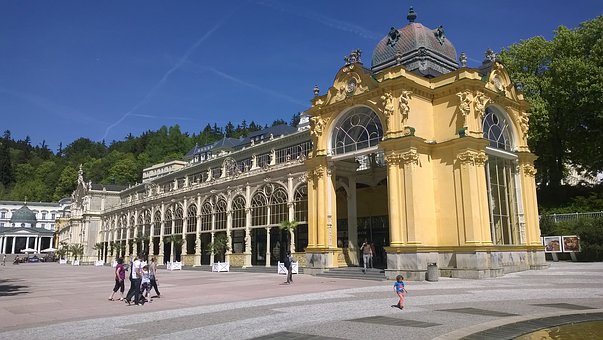Backpacking in Czech Republic
Culturally rich cities and beautiful landscapes create a wonderful symbiosis that can be discovered while travelling in the Czech Republic. The Czech Republic has an area of around 78,000 square metres, where more than ten million people live. The country used to be divided into seven regions: North, East, South and West Bohemia plus Prague and South and North Moravia. They do not represent political or cultural unity. Today the Czech Republic has 14 administrative districts.
The interior of Central Europe borders Germany to the west, Austria to the south, Slovakia to the east and Poland to the north. Despite a good infrastructure throughout the country, most travellers are attracted to Prague, although there is much more to discover. These include fascinating, enchanted landscapes, dreamy towns and villages as well as mountain regions and relics reminiscent of the country’s history. There are numerous UNESCO World Heritage Sites, as well as nineteen sites on the Tentative List waiting to be included in the World Heritage List.
A very well developed rail and road network makes travelling in the Czech Republic very pleasant. A toll is payable for driving on motorways and expressways, which is paid in the form of a car vignette. Rail transport can look back on 160 years of tradition.
The use of public transport such as buses and trains varies greatly in price. Prague, with over 1.2 million inhabitants, is the economic, cultural and spiritual centre. During your backpacking tour through the Czech Republic you will experience a moderate continental climate, as the region lies in a transitional zone and is influenced by the Central European-oceanic and Eastern European-continental climate.
The national currency is still the Czech Crown (CZK/Kč), although the Czech Republic belongs to the European Union. But in many places in big cities, hotels, restaurants and shops you can pay with Euro. The exchange rate is set by yourself, however, so you’ll have a much worse chance of getting away with it. Therefore, you should buy enough Czech crowns.
You can get money at most Czech ATMs with the EC card or the usual credit cards. Cheap withdrawals are possible at Deutsche Bank, Wüstenrot Bank and Commerzbank, as they have branches in the Czech Republic. An alternative is the purchase of a so-called travel credit card, because these providers generally do not charge any foreign assignment fees for the use of third-party machines or foreign vending machines. Only the usual fees apply.
In the Czech Republic the official language is Czech. In many cases, the older population also speaks and understands German. Younger people tend to speak English.
Culture in the Czech Republic
The Czech Republic is a direct neighbour of Germany and connected by a very long, common and changeable history. That is why the two cultures have always influenced each other. This does not mean the culinary culture, but the many cultural similarities. During your backpacker trip you will nevertheless encounter cultural differences.
Since the Czech Republic has been occupied and dominated by foreign powers over the centuries, many traces of this can be found in the culture and mentality of the Czechs. A certain amount of manners is part of polite behaviour. Good day (dobry den) and goodbye (na shledanou) should already be mastered in the national language.
If you are invited home, a small present is part of the good tone. In the Czech Republic it is customary for you to remove your shoes before entering the house. If you ask for the way, you should know the Czech name of the town or village.
Apart from hospitality, the Czechs are very sociable. This is clearly reflected in the pub and beer culture. During your trip you will come into contact with the older and younger generations. For the older generation the feeling of security, conformity and tradition has a high priority. The younger generation, on the other hand, favours creativity and a lot of personal freedom, which they fully live out.
More Backpacking Information about Czech Republic
Compared to Germany, the Czech Republic is generally lower in price level. However, there are some things you should keep in mind when travelling in the Czech Republic in order to get cheap prices and bargains. Generally speaking, non-imported products and services are cheaper. So you can comfortably cover your daily needs with 50 – 70 Euro.
Besides extensive city trips and hikes in the mountains and through fantastic landscapes, you will find a lot of culture in many places and especially in Prague. Depending on how you plan your trip, each season has its own special side. However, it gets quite cold in winter. Therefore, you should choose your travel time according to your preferred travel wishes.
There are many different places to stay in the Czech Republic. However, it is often difficult to find good and cheap accommodation. Everywhere in the Czech cities there is the former, official hotel, which originates from the communist time and has little in luxury to offer.
However, there are more and more locals who offer rooms with half board for around 20 euros per night. The prices in new, modern hotels are similar to those in Germany. In a hostel you pay for an overnight stay between 300 CZK/11 Euro and 600 CZK/22 Euro.
The Czech Republic is known not only for its excellent beers, but also for its traditional cuisine, which you should definitely try in the numerous restaurants and pubs. A meal in a restaurant costs on average 600 CZK/ 23 Euro, in a pub around 150 CZK/ 6 Euro.
Backpacker Budget in Czech Republic
Traveling and living in the Czech Republic is somewhat cheaper than in Germany. In cities like Prague, where there are a lot of tourists and backpackers, the prices are similar to other European metropolises. In the city centre you pay almost the same as for hotels and restaurants as in Germany.
However, if you are looking for a few streets further on, choose another neighbourhood and want to visit other places in the Czech Republic, you will find many cheap restaurants and accommodation as well as hostels and privately rented rooms. With 50 – 70 Euro per day you can make ends meet.
For a meal in a pub or a traditional Czech restaurant you only pay 5 Euro. At 10 Euros you will be really satisfied and provided with good food. But for gastronomic highlights you should plan at least 20 Euro. Those who like to eat Mc Donalds pay 2,80 Euro for a Big Mäc.
Local draught beer costs between 1.50 and 3 euros. However, there is a half litre of beer for the price. Elsewhere there is a beer already for 0,60 euro. Coffee drinkers have their bright joy, because a cup of coffee costs only 1 euro.
Admission prices for sightseeings, museums and galleries range on average from 3 to around 6 euros. For the biggest and most important sights like the Prague Castle and the Jewish Museum you can pay 14 Euros and more.
Take a taxi Tram in the Czech Republic
In the city centre of Prague, the tram is a cheap means of transport. You can buy your tickets mainly at ticket machines or newspaper kiosks. Prague offers for your backpacker trip discounted tourist tickets, which cover a larger number of trips.
In addition to trams, there are also subways and buses. A ticket for public transport with a journey time of 90 minutes costs approximately 1.40 euros. For a 24-hour ticket you pay around 5 euros.
Taxi travel is cheaper in the Czech Republic than in Germany. The city tariff is 1.12 euros. In addition, the basic price is 1.60 euros. Since taxi drivers always demand excessive prices, you should pay close attention to who brings you from A to B. Recommended taxi companies are for example Profitaxi and AAA Radiotaxi.
Buses in the Czech Republic
A fast and popular means of transport in the Czech Republic, especially for your backpacker trip, are the numerous bus connections. The bus stations are usually located close to the city centre and are easily accessible. Especially on weekdays there are numerous connections between the larger cities on the timetables several times a day. Smaller cities are served once a day.
There are hundreds of larger and smaller private bus companies. In order to give you an idea of the connections between individual cities, the 1 hour and 45 minute journey from Prague to Königsgrätz or the 2 hour journey from Brno to Prague can be mentioned.
Rail travel in the Czech Republic
Rail travel in the Czech Republic is a special and inexpensive experience that you shouldn’t miss on your backpacker trip. You will get a positive impression of the classic railway trip. There are still the popular compartment cars with soft cushions, as well as numerous staffed ticket counters, especially at smaller stations.
In addition to long-distance routes, small rail buses run on secondary routes. They offer little comfort and are well below the Western European level. In recent years, however, a number of rail buses have been replaced by new local trains.
The SC Supercity is an express train that runs several times a day between Prague and Strava and once a day between Prague and Brno or Bratislava. A train journey between Prague and Ostrava, for example, in a 2nd class compartment with a seat ticket costs about 26 euros, and between Prague and Brno about 21 euros.
Backpacker Route in Czech Republic
When travelling through the Czech Republic you can enjoy the indescribable nature and an even greater variety of cultural impressions that make the country so special. In North Bohemia, besides the industrial areas, there are dreamlike nature reserves with bizarre rock formations and wildly romantic castles. The Elbe Sandstone, Giant and Jizera Mountains invite you to hike and climb.
West Bohemia offers you a backpacker trip with several landscapes. There is the Egerland basin, surrounded by the Upper Palatinate Forest, the Fichtelgebirge and the Kaiserwald. There are numerous mineral springs, not only in Karlovy Vary, but West Bohemia is also known for its many spas.
Prague is the main attraction in Central Bohemia. The so-called “Diadem am Hals Europas” is surrounded by seven hills and offers a varied history. More than five hundred towers rise into the sky and more than one hundred sacred buildings form the cityscape. The Vltava flows through this urban beauty. In addition to the obligatory cultural programme, there are fantastic landscapes that you should not miss out on as a backpacker.
In the South Bohemian district, untouched forests await you, which are broken through by lake landscapes. Spacious castles and fairytale palaces on green hills, Renaissance towns and urban life in the university town of Český Budějovice are just waiting to be discovered by you on your journey.
There is much nature to marvel at in East Bohemia and in the picturesque North Moravia. Beside gentle hill landscapes and the Renaissance city Pardubice the high plateau radiates Vysočina a Tuskan fascination. North Moravia, on the other hand, offers not only the hectic hustle and bustle of a big city but also rural solitude, rushing brooks and beautiful woodlands where a white Renaissance castle is embedded.
Picturesque small towns with Mediterranean charm invite you to extensive wine tastings. The question quickly arises as to what you should not miss on your backpacker trip to the Czech Republic.
Route 1: The classic (15-21 days)
- 2-3 days exploring Prague, the lively capital city
- 2 days roaming through Pilsen
- 3 days enjoying Karlovy Vary and relaxing in thermal springs
- 2 days Děčín on the Elbe, discover the Bohemian Switzerland and Bohemian Central Grb Mountains
- 2 days Frýdlant in the foothills of the Jizera Mountains
- 2 days hiking through Harrachov at the edge of the Giant Mountains
- 2-3 Day Experience Spindleruv Mlyn and the Giant Mountains
- 2 days exploring Jicin, experiencing landscape and culture
- 2 days Hrad Kost, visit castles Kost
- 2 days to discover Kokorin and the beauty of the Kokorinsko nature reserve
Route 2: Backpacker Intensive Trip (up to 30 days and more)
- 3-4 days exploring Prague, experiencing culture and history
- 2 days discover Jabkenice
- 2 day exploring Svitavy
- 2 days experience and discover Olomouc, the second oldest university city
- 3 days Moravian Karst with its indescribable landscape experience
- 3-4 days Brno. Even in the second largest city there is a lot to discover
- 3 days exploring Lednice with castles, palaces and the Apollo Temple
- 2 days wander Mikulov with castle, cathedral chapter houses and synagogue
- 2 Days Discovering Jindrichuv Hradec in the Historic Region of Bohemia
- 2 days wandering through Pilsen and experiencing the city up close
- Enjoy 4 days Marienbad and Franzenbad
- 3-4 days enjoying Karlovy Vary and relaxing in the thermal springs
Travel times in the Czech Republic
The Czech Republic is generally subject to a moderate continental climate, as the country lies in a transitional zone between the Central European-oceanic and the Eastern European-continental climate. This means that the winters are quite mild and the summers hot, but also cooler. In the mountains above 1,100 metres, subalpine conditions prevail, in higher altitudes alpine conditions with lots of snow.
The climatic conditions are strongly influenced by the many mountains, so that they offer good protection to the basins. Therefore it is rather dry and never too hot. The precipitation gets stuck on the peaks of the mountains and goes down there as rain or snow. Fast weather changes included. In Prague, peak temperatures of up to 35°C are reached in summer.
The optimal travel time for your backpacker trip results from what you want to experience on your tour. For a city trip and the well-known spas, May, June and September are optimal, as the weather is quite good and the places are not too crowded. If you want to combine your backpacking trip with winter sports activities, the period between January and March is perfect, as the snow conditions are usually very good and mostly well groomed slopes are offered.
Backpacker accommodations in Czech Republic
The Czech Republic is a relatively cheap travel destination and offers a whole range of accommodation options, which vary greatly in price. Especially in the city centre of Prague it is much more expensive than on the outskirts. Those who want it cheap should look out for simple hostels.
As an alternative there are of course also modern hotels where you can stay. But the prices in these hotels are similar to those in Germany. But there are also locals who rent rooms with half board to backpackers, where you pay just 20 euros for a room with half board.
Youth hostels and hostels are also ideal and inexpensive. A look at the hostel page Hostelworld will show you some great offers. But what does a bed in a hostel cost? The prices for an overnight backpacking stay in the Czech Republic are as follows:
- Prague 12 – 18 Euro
- Cesky Krumlov 14 – 20 Euro
- Brno 10 – 20 Euro
- Olomouc 16 – 20 Euro
- Ceke Budejovice 15 – 25 Euro
- Tabor 12 – 18 Euro
- Post codes 18 – 25 Euro
- Jindrichuv Hradec 14 – 20 Euro
Sometimes the prices vary considerably. It is therefore worth taking a closer look to find a suitable accommodation with a good price/performance ratio. Motels also always offer great offers for an overnight stay.
Motels on exit roads and motorways
An interesting overnight option are the different motels. They often offer you a restaurant, a parking lot directly in front of the door, are easy to reach and have free WLAN. A double room with bathroom and TV is available from 25 Euros. You can find them on motorways, exit roads and also in the suburbs.
Backpacker Trips & Tips in Czech Republic
As a backpacker travelling the country and the cities is one thing, getting to know the culture of the Czechs and experiencing a completely different one. On your backpacking trip you will get to know history and cultural history first hand. Each region has its own characteristics and a rich spectrum of cultural beauty.
Besides Prague, larger cities you should have seen include Plzen (Pilsen), Ceske Budejovice (Budweis), Brno (Brno), the famous spas such as Karlovy Vary (Karlsbad), Marianske Lazno (Marienbad) or Frantiskovy Lazne (Franzensbad).
Scenic gems, magnificent nature reserves, mountain ranges such as the Giant Mountains and wildly romantic castles, as well as sacred buildings are just waiting to be discovered, explored and visited by you. Around Prague there is the Divoká Šárka reservoir and bathing lakes in Hostivař and near Řepy and Poděbrady, where you can spend a relaxing day. Limestone rocks, near the place where the Louděnice flows into the Berounka, land for free climbing.
Backpacker Highlights in the Czech Republic
One of the highlights in the Czech Republic is shopping, even though the price difference has not been quite so great since the fall of the Iron Curtain and EU accession. Because there are still high-quality products, mouth-blown and carved pieces for considerably less money. Jewellery made according to your wishes is available at attractive prices.
Because the low hourly wage has a positive effect on prices, especially if you want gold jewellery or garnet set brooches, rings or chains. Shoes of the Czech manufacturer Bat’a are in no way inferior to German products and are cheap and of good quality.
Shopping is exciting not only in the shops, but also on the many markets, where you can find nice things for yourself or souvenirs for those who stayed at home. There are no general opening hours in the Czech Republic. Smaller shops close at about 7 pm, others are open 24 hours a day.
Backpacker insider tips in the Czech Republic
To get to know Prague from a different perspective, away from the main tourist attractions, it is worth visiting the Vyšehradist quarter of Prague, where there are few tourists. Vyšehrad is a rampart over the southern New Town and is one of the most historically significant places in Prague.
Another place not to be missed is the Lucerna Passage in a side street from Wenceslas Square. As soon as you enter the Passage, you’ll feel like you’re back in the golden 20s, which are still very much alive here. You’ll quickly get an idea of what Prague once looked like. A beer tour through Prague is just as exciting.
A secret tip are private tours through Prague, which are conducted by a tour guide who knows the city like the back of his hand. Of course the tours are in German. Even if the guides are not native speakers, you can understand them very well. You will get a first impression of the mysterious Prague with many informative, funny and well-founded insights.
In addition to the dreamlike cities, there is a variety of landscapes with a feel-good factor to discover, because each region has its own unique characteristics. Especially in West Bohemia there is a special tradition. It is the Chod festival and the Laurentius pilgrimage, which take place once a year in the town of Domazlice.
There are dances, folk dude bag music, original customs and habits that you can participate in during your trip. You will experience the Chodsko region, which is a region of Western Bohemia, at one of the oldest folklore festivals in the Czech Republic. You shouldn’t miss it, but immerse yourself in the unique tradition and experience it first hand.
Food & Drinks in Czech Republic
Czech cuisine is inspired by traditional Old Bohemian recipes, where home-grown ingredients form the basis of cooking and preparation. The main ingredients used in the preparation of food are pulses, cereals, potatoes and meat, which, in combination, make an imaginative and delicious meal.
The simple ingredients are used to make numerous dumplings, sweet pastries, delicious roasts and a wide selection of soups and sauces. The Czech food culture does not differ from the traditional German one. Breakfast, lunch and dinner are served throughout the day. The most important meal is lunch, as soup, main course and dessert or salad are usually eaten.
Food in the Czech Republic
Meat is an integral part of the main courses in the Czech Republic. The most common dishes are poultry, pork and beef, and lamb, fish and game are rare. A typical Czech dish is roast pork with cabbage, dumplings and lots of sauce. Beef is usually served with various sauces.
A special delicacy are soups like potato soup with a lot of marjoram, sauerkraut soup, beef soup with liver dumplings and goulash soup, which are served with bread. Dumplings are not only served with the main course, but can also be found at dessert. They are made from yeast dough, quark or semolina, filled with East or sprinkled with poppy seeds.
Each region has its own local specialities, which you should definitely taste when backpacking in the Czech Republic. Prague has Prague ham, Pardubice is famous for gingerbread and Karlovy Vary for wafers. There are also Olomouc Quagels from the North Moravian town, fragrant hand cheese and Kolatsch from Wallachia.
Drinking in the Czech Republic
Drinking in the Czech Republic will get you through fast. Because you know Budweiser beer and Pilsener guaranteed, because they are known worldwide. The beers are the number one national drink. When you visit the legendary Prague beer halls, you’re surrounded by a mystical aura. Meanwhile there is also an interesting wine guide, since there are quite good wine productions from certain regions in the Czech Republic. However, wine is not typical for the country.
Schnapps like Becherovka and Absinthe are now available from Czech distilleries. Becherovka, a bitter herb, is made according to a secret recipe from herbs, alcohol and oils. There is also Fernet Stock and the national drink number two, Slivovice, which ensures a long life.
The bottles for the various drinks are also produced in the country and are world-famous. In the Czech Republic, the “Na zdravi!” is the name of a drink, which literally means “to your health”.
Backpacker Visa and Vaccinations in Czech Republic
No visa is required for your backpacker trip through the Czech Republic, so you can enter without a visa. You only need valid entry documents. According to the Foreign Office, the entry requirements for the Czech Republic are as follows:
- Passport: Yes
- Provisional passport: Yes
- Identity card: Yes
- Temporary identity card: Yes
- Children’s passport: Yes
Comments
The travel documents must be valid until the end of the trip. Children’s entries in a parent’s passport are no longer valid. All children need their own identification document for entry into the Czech Republic.
Medical information & vaccinations for the Czech Republic
You can enter the country without a vaccination, but it is advisable to have the standard vaccinations of the Robert Koch Institute up to date. For long-term stays a vaccination against hepatitis B, rabies and the TBE virus infection transmitted by ticks is recommended. There is good medical care in the Czech Republic, which you can take advantage of with your insurance card.

